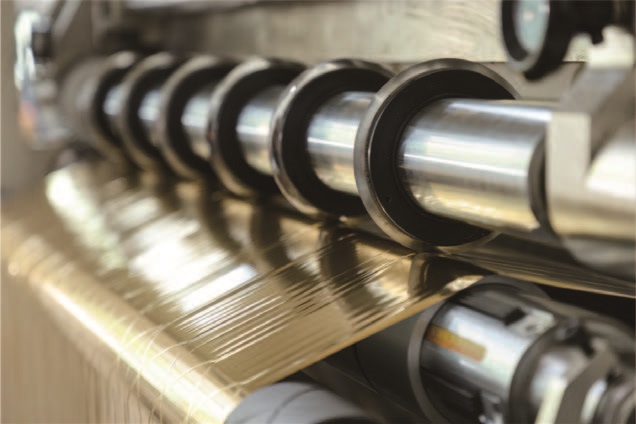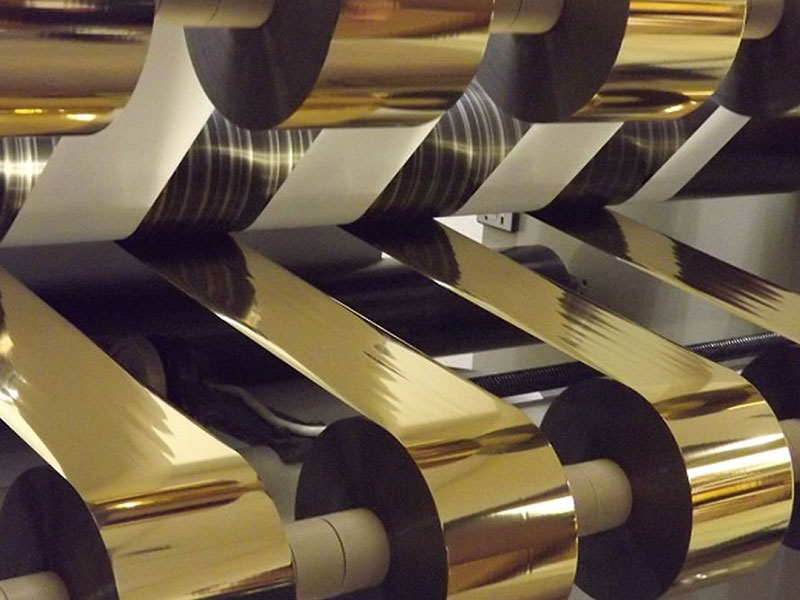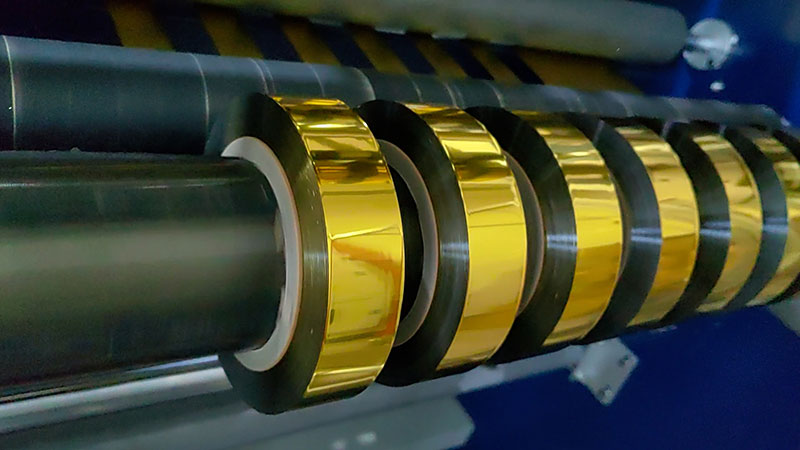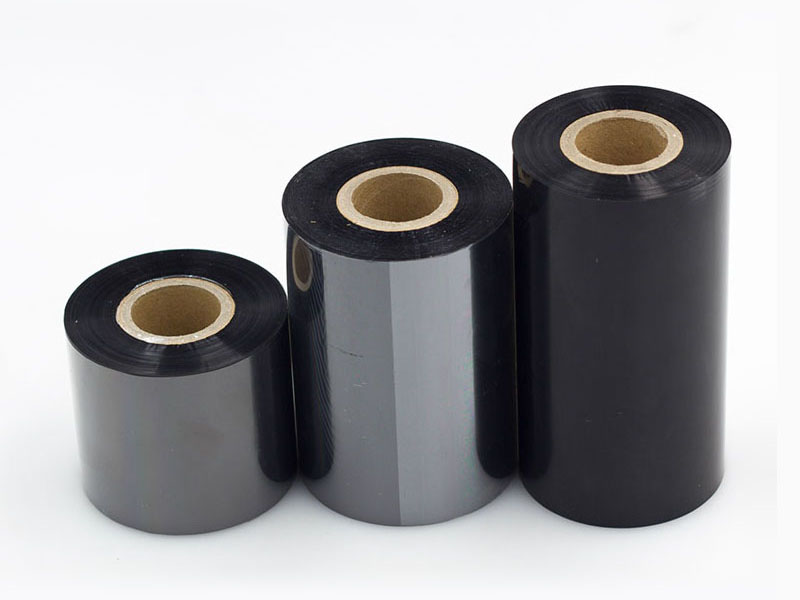Slitters, Rewinders & Packaging Machines - Slittin
As a leading manufacturer in the slitting machine field, we have won wide acclaim from customers around the world through innovative technology, high-quality products, and professional services.
Hot stamping foil slitting machine: precise slitting, enabling efficient hot stamping
In industries such as packaging, printing, gifts, and luxury goods, the foil stamping process has always occupied a key position in enhancing product value with its unique metallic texture and luxurious atmosphere. That touch of brilliant gold, silver or brilliant colored foil is a silent declaration of quality and nobility. However, behind this dazzling visual effect, a seemingly inconspicuous but crucial link is determining the success or failure and efficiency of the foil stamping effect - that is, the cutting of foil stamping. The hot stamping foil slitting machine is the "behind-the-scenes hero" of this link, injecting strong momentum into the modern hot stamping process with its ultimate accuracy and reliable efficiency.

Precise slitting: the cornerstone of foil stamping quality
The slitting of hot stamping foil is by no means simply "cutting". It is a technical work that requires extremely high precision.
• Zero-defect edges: High-quality slitting machines use sophisticated knife systems and constant tension control to cut wide raw material master coils into specific widths required by customers. The cutting surface must be smooth and straight, free from any burrs, flanges, or jaggings. Any minor imperfections can lead to foil breakage, step skips, or uneven edges of the hot stamping pattern during the high-speed hot stamping process, directly leading to material waste and defective products.
• Ultimate Slitting Precision: For positioning hot stamping with precise alignment requirements, or for applications on narrow labels and small text, the slitting accuracy of the slitting machine is crucial. The width tolerance must be stably controlled at the micron level to ensure that each roll of slitted gold leaf perfectly matches the pattern on the hot stamping machine, achieving "zero error" registration.
• Protecting Coating Integrity: The hot stamping foil itself has a complex structure and usually consists of a base film, release layer, color layer, aluminum plating layer, and glue layer. Rough slitting can damage its microstructure and affect peeling and transfer results. Professional hot stamping foil slitting machine can complete clean and neat slitting without damaging each functional layer, ensuring that the excellent performance of the gold foil itself is fully preserved.
It can be said that without precise slitting, there is no high-quality hot stamping. The hot stamping foil slitting machine lays a solid foundation for the subsequent gorgeous presentation by defending this "first line of defense".

Empowering efficiency: driving the engine of hot stamping production
In an increasingly competitive market environment, production efficiency is the lifeline of an enterprise. The hot stamping foil slitting machine plays an irreplaceable role in "empowering efficiency".
• Flexible application of large-format master rolls: Hot stamping foil manufacturers often produce large, wide master rolls for easy transportation and storage. The slitting machine allows it to be flexibly slitted into various widths according to the wide variety of product needs of the end customer. This not only reduces the inventory pressure of customers, but also avoids the waste of narrow use of wide foil, maximizes the use of materials, and significantly reduces the overall cost.
• Improve the operating efficiency of the hot stamping machine: The gold foil roll with precise slitting, neat winding, and uniform tension runs smoothly on the high-speed hot stamping machine, greatly reducing the number of downtimes caused by problems such as foil breakage and deviation. Operators do not need to frequently change materials, thread foils, and adjust, and the equipment can continue to operate efficiently, directly increasing production capacity and per capita output value.
• Automation and intelligence: Modern high-end slitting machines have integrated automation and intelligent control technology. Functions such as automatic deviation correction (EPC), tension closed-loop control, automatic shutdown at fixed length, data logging and analysis not only reduce the skill requirements for operators, but also ensure the consistency, stability and traceability of each batch of slitting products, making production management leaner.
Conclusion: Small equipment, big deeds
Although the hot stamping foil slitting machine is in the middle link of the industrial chain, its value runs throughout. It is a bridge between raw materials and end applications; It is an actuary who calculates the value of materials down to millimeters; It is also an enabler, escorting the gorgeous blooming of the hot stamping process with its stability, precision and efficiency.
When we appreciate the exquisite foil stamping effect on a dazzling array of products, we should not forget that it also embodies the wisdom and power contributed by the foil foil slitting machine. Precise slitting and efficient hot stamping - this is not only a description of the function of a piece of equipment, but also a perfect interpretation of the entire industry's pursuit of excellence and excellence.
Hot stamping foil slitting machine: a sharp tool to achieve zero waste of hot stamping materials
In the packaging and printing, gift making and high-end label industries, the foil stamping process has always occupied an irreplaceable position with its unique metallic texture and luxurious atmosphere. However, behind this dazzling effect, a long-standing pain point plagues countless enterprises - the waste of hot stamping materials.
When using traditional whole roll hot stamping foil, it often needs to be cut due to the different width of the substrate or the needs of the pattern. Cutting by hand or simple equipment is not only inaccurate and inefficient, but also produces a large amount of leftovers and unusable foil, which directly erodes the profits of enterprises. It was not until the emergence of the hot stamping foil slitting machine that this pain point was truly turned into history and became an industry tool to achieve zero waste of hot stamping materials.

1. What is "zero waste"? How does a slitting machine work?
The so-called "zero waste" does not mean absolute physical loss, but the optimal solution between maximizing utilization and minimizing waste. It is through their sophisticated technology that the hot stamping foil slitting machine brings this concept to life.
1. Customized on demand, accurate matching
The core function of the slitting machine is to accurately slice the standard width of the mother roll gold leaf into a variety of sub-rolls of different widths according to the actual needs of the production order. This means that whether your product requires 10mm, 25mm, or 50mm wide gold leaf, the slitter can efficiently and precisely cut from the same master roll, avoiding the waste of material on both sides caused by using overly wide gold leaf.
2. Eliminate the "ineffective width" and make the best use of it
In many cases, the hot stamping pattern occupies only a part of the substrate. If it is not cut, only a part of the entire wide roll of gold leaf is used, and the rest becomes a useless "foil" and is eventually discarded. Through precise slitting, the slitting machine makes the width of the gold leaf perfectly match the width of the hot stamping pattern, and truly achieves "as wide as you need", which fundamentally eliminates the waste caused by "invalid width".
3. High-precision control to reduce debugging and joint loss
Modern high-end slitting machines are equipped with sophisticated tension control systems and photofilm image positioning systems, ensuring that the coils are flat and the edges are smooth and burr-free during the slitting process. This not only ensures the smoothness and high quality of the subsequent hot stamping process, but also reduces production failures such as paper jams and foil breakage caused by uneven slitting. At the same time, precise cutting also means fewer joints and higher effective material utilization when changing coils.

2. The multiple benefits brought by the slitting machine
The introduction of hot stamping foil slitting machine not only brings material savings, but also an all-round benefit improvement.
• Significant economic benefits: directly reduce the procurement cost of hot stamping foil and increase the material utilization rate to more than 90%. What is saved is what is earned. In the long run, this is an extremely considerable return on investment.
• Improved production efficiency: The pre-slitted gold coils are perfectly matched with the machine, reducing the time of downtime during the production process to change coils and adjust alignment, making the production process smoother and more efficient.
• Enhanced flexibility to meet small batch customization: In today's market trend towards personalized and small batches, slitting machines enable enterprises to flexibly respond to orders of various specifications without hoarding a large amount of gold foil inventory of different specifications for special widths, reducing inventory costs and capital occupancy.
• Practice environmental protection: Reducing waste is the most direct environmental protection behavior. By minimizing the waste of gold leaf (which contains plastic film and metal coating), companies can effectively reduce the generation of industrial waste, fulfill their social responsibilities, and create a green and high-end corporate image.

3. Selection and prospects
When choosing a hot stamping foil slitting machine, enterprises should pay attention to its slitting accuracy, stability, degree of automation (such as automatic deviation correction, data memory), and adaptability to different materials of gold foil (such as paper foil and polyester foil). An excellent slitting machine is a key part of the production system.
All in all, the hot stamping foil slitting machine has been upgraded from an optional auxiliary equipment to a core tool for reducing costs and increasing efficiency and lean production in modern hot stamping processes. It pushes expensive foil stamping materials from "probably usable" to "accurate and easy to use" era, so that every inch of gold leaf shines on the final product, rather than sitting in the scrap bin.
In an increasingly competitive market environment, details make or break the truth. Embracing the technology of hot stamping foil slitting machine is not only saving costs, but also in forging the core competitiveness of forging enterprises for the future, achieving a perfect balance between luxury and efficiency.
Is your ribbon really "cut" right? Demystify the importance of ribbon slitting machines
In the world of barcode printing, we often focus on the performance of the printer, the quality of the label paper, or the chemical composition of the ribbon itself (wax-based, hybrid-based, resin-based). However, there is a crucial link that is often overlooked, which is hidden before the ribbon leaves the factory, but directly determines the success or failure of your printing effect and the level of cost - that is, ribbon slitting.
Have you ever encountered the following problems?
• Frequent "jumpers" and incomplete handwriting when printing?
• Ribbon suddenly breaks during printing, causing print interruptions and material waste?
• Printed labels with blurred edges or uneven ink color?
• Ribbon unwound, loose or stuck on the shaft?
If the answer is yes, then your problem may not be with the ribbon material or printer, but with your ribbon, which was not "cut" right in the first place.

Slitting machines: the "precision cutters" of ribbon production
The ribbon is a wide master roll when it leaves the factory, and needs to be cut into finished products of different widths such as 40mm, 60mm, 80mm according to the specifications of the customer's printer. This process is completed by ribbon slitting machines. It seems to be just a simple cutting device, but it is actually a highly demanding "precision cutter".
A good slitting machine and a poor quality slitting machine produce a world of difference in carbon zone. Its importance is mainly reflected in the following dimensions:
1. Cutting Precision: The cornerstone that determines print quality
• Precise width: The slitting machine must ensure that the width of each ribbon is absolutely accurate and accurate. Even an error of 0.1 mm can cause the ribbon to deviate during printing, and the edges cannot be completely pressed by the print head, resulting in blank printing or contamination of the printer roller.
• Smooth Cutting Edges: High-quality slitting machines use fine sharpening blades or ultrasonic cutting techniques to produce smooth, flat, and burr-free cutting surfaces. Inferior slitting will produce burrs and chips, which will fall off during the printing process, causing print stains at best, and getting caught in the print head at worst, causing permanent damage.
2. Rewinding tension control: the key to affecting operational stability
• Uniform tension: The best-in-class slitting machine has a sophisticated tension control system that ensures that the ribbon is subjected to uniform force during winding and that the coil is tight and flat.
• Avoid "collapsed" and "chrysanthemum": Uneven tension can cause ribbon rolls to appear "sagged" (uneven edges) or internal creases. After such a ribbon is put on the machine, the tension changes suddenly during operation, which can easily lead to breakage, wrinkling, or even directly tearing off the print head.
3. End face flatness: A visual reflection of the user experience
A ribbon with a mirror-like end face is not only beautiful, but also represents the stability of the internal structure. It means that the ribbon releases smoothly during high-speed printing, reducing jitter and ensuring consistent printing results on every label.

Neglecting slitting quality, what will you face?
Choosing a poorly slitted ribbon is like planting a "ticking time bomb" for your printing job:
• Reduced print quality: Broken wires, false typing, and contamination directly affect the readability and professionalism of labels, especially on barcodes that need to be scanned, which can lead to serious consequences that cannot be recognized.
• Reduced production efficiency: Frequent downtime to deal with broken belts and clean printheads greatly reduces the efficiency of automated production lines and delays order delivery.
• Increased operating costs: Ribbon waste, label paper waste, and equipment repairs, especially expensive printhead replacements, can creep up.
• Increased equipment loss: Ribbon chips and abnormal tension can accelerate the wear of the print head and rollers, reducing the life of the printer.

How can you tell if your ribbon is "cut" correctly?
When choosing a ribbon, in addition to paying attention to the brand and type, be sure to be a "person with a heart":
1. Look: Observe whether the end face of the ribbon coil is flat and whether the edges are smooth and burr-free.
2. Hand touch: Gently touch the edge of the ribbon to feel if there is a noticeable roughness or powder peeling off.
3. Trial: Go to the machine for a high-speed printing test, observe whether the operation is smooth and smooth, and check whether the label edges and print head are clean after printing.
epilogue
"If you want to do a good job, you must first sharpen your tools." As the "ink" of barcode printing, the slitting quality of ribbon is the invisible cornerstone to ensure the stable and efficient operation of the printing system. Next time, when you purchase ribbon, don't just ask about the price and type, but ask more: "How is your slitting process?" ”
Is your ribbon really "cut" right? Choosing a supplier with advanced slitting equipment and rigorous craftsmanship is the wisest investment in your print quality, equipment life, and overall operational efficiency. Because details determine success or failure, precise slitting is the indispensable soul of high-quality ribbon.
Commentaires